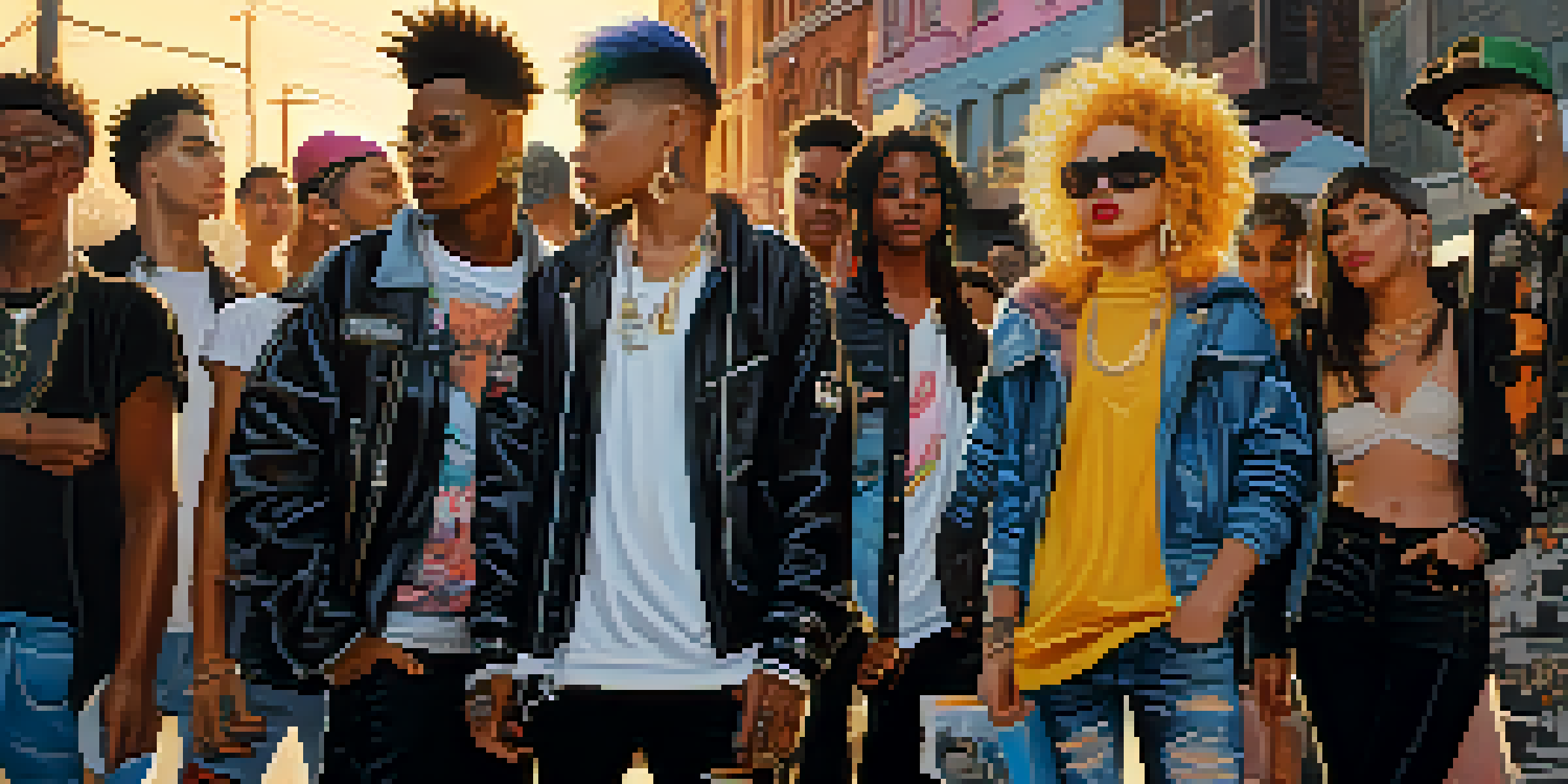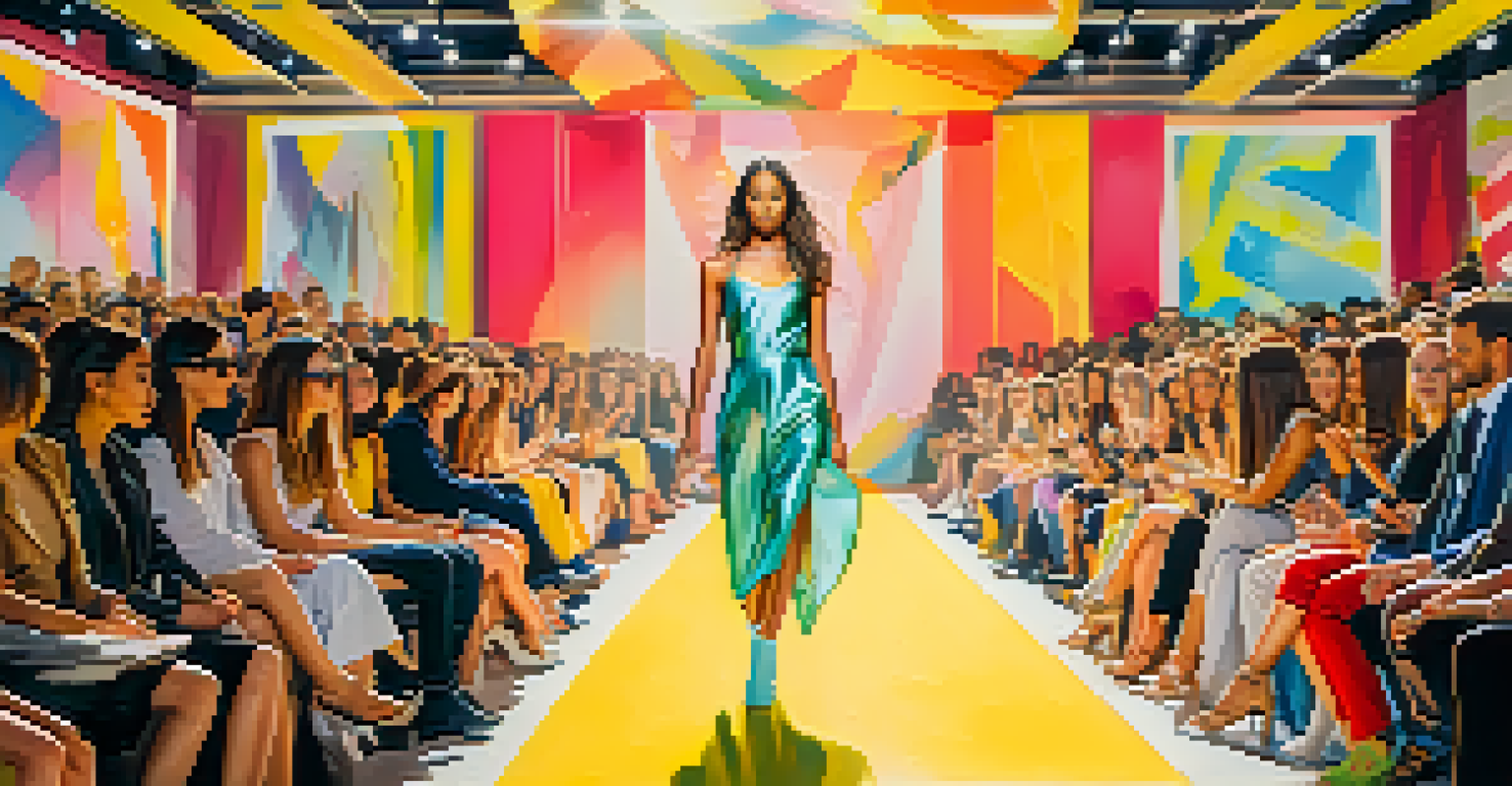Fashion Subcultures: Defining Youth Identity and Community

Understanding Fashion Subcultures and Their Impact
Fashion subcultures are groups of people who express their identity through unique styles and trends. These subcultures often emerge from shared interests, beliefs, or experiences, allowing individuals to connect on a deeper level. By adopting specific fashion choices, members signal their belonging to a community, which can be both empowering and unifying.
Fashion is the armor to survive the reality of everyday life.
For instance, the punk subculture, characterized by its edgy clothing and rebellious attitude, arose in the 1970s as a reaction against mainstream culture. Members used fashion as a way to express their dissatisfaction with societal norms. This illustrates how fashion can serve as a powerful form of self-expression and a tool for social commentary.
Moreover, these subcultures evolve over time, influenced by cultural shifts and technological advancements. As the digital age progresses, online platforms have allowed subcultures to thrive, creating virtual communities that transcend geographical boundaries. With this evolution, fashion remains a vital element in defining youth identity.
The Role of Fashion in Youth Identity Formation
Fashion plays a crucial role in shaping youth identity as it offers a canvas for self-expression and individuality. For young people, experimenting with different styles can be a way to explore their identity and beliefs. This exploration often leads to a deeper understanding of who they are and where they fit in society.

Consider the goth subculture, where members often dress in dark, dramatic clothing that reflects their artistic sensibilities and rejection of mainstream culture. By embracing this aesthetic, they create a distinctive identity that resonates with their values and experiences. This illustrates how fashion can be a reflection of personal beliefs and emotions.
Fashion as Identity Expression
Fashion subcultures provide a unique platform for individuals to express their identities and connect with like-minded communities.
As youth navigate the complexities of identity formation, fashion becomes a tool to communicate their unique perspectives. By aligning with specific styles, they not only express individuality but also foster connections with like-minded individuals, reinforcing their sense of belonging within a community.
Community Building Through Fashion Subcultures
Fashion subcultures often function as tight-knit communities where members share similar values and interests. These communities provide a safe space for individuals to express themselves without judgment, fostering a sense of belonging. Through shared experiences, members cultivate relationships that can last a lifetime.
Clothes mean nothing until someone lives in them.
Take the hip-hop culture, for example. It has created not just a fashion statement but a movement where music, dance, and style converge. This interconnectedness has allowed individuals to bond over their shared love for hip-hop while celebrating their unique styles. Such communities empower young people to showcase their creativity and individuality.
Moreover, community events like fashion shows or meet-ups further strengthen these bonds. They provide opportunities for members to come together, share ideas, and inspire one another. In this way, fashion subcultures not only shape identity but also create vibrant and supportive communities.
The Influence of Social Media on Fashion Subcultures
Social media has revolutionized the way fashion subcultures are formed and shared. Platforms like Instagram and TikTok allow individuals to showcase their unique styles to a global audience, fostering connections with others who share similar interests. This visibility can lead to the rapid spread of trends and the emergence of new subcultures.
For instance, the cottagecore aesthetic gained immense popularity through social media, celebrating a romanticized rural lifestyle characterized by vintage clothing and nature-inspired themes. This subculture has created a sense of community among its followers, who share tips on sustainable living and DIY fashion projects. It highlights how social media can amplify niche interests and foster connections.
Social Media's Role in Trends
Social media has transformed how fashion subcultures are formed and spread, enabling global connections and the rapid emergence of new trends.
Additionally, influencers and content creators play a significant role in shaping these subcultures. By curating specific looks and lifestyles, they inspire their followers to adopt similar styles. In doing so, they contribute to the evolution of fashion subcultures and help build a sense of community among their audience.
Fashion as a Form of Resistance and Empowerment
For many youth, fashion serves as a form of resistance against societal norms and expectations. By choosing to dress in ways that defy conventions, individuals can challenge stereotypes and assert their identities. This empowerment through fashion can be particularly significant for marginalized groups seeking to reclaim their narrative.
The queer community, for example, has long used fashion as a means of self-assertion and visibility. From vibrant colors to bold styles, members express their identities and challenge traditional gender norms. This act of defiance not only fosters individual empowerment but also encourages acceptance and understanding within society.
Moreover, fashion can be a catalyst for social change. Movements like Black Lives Matter have integrated fashion as a tool for activism, using clothing and accessories to spread awareness and solidarity. Through these efforts, individuals show that fashion is not merely about aesthetics; it can be a powerful medium for expressing values and advocating for justice.
The Evolution of Fashion Subcultures Over Time
Fashion subcultures are not static; they evolve in response to cultural, social, and economic changes. As society progresses, so do the styles and values associated with these subcultures. This fluidity allows fashion to remain relevant and reflective of contemporary issues faced by youth.
For instance, the rise of eco-consciousness has led to the emergence of sustainable fashion subcultures. Young people are increasingly drawn to vintage clothing and thrift shopping as a way to combat fast fashion's environmental impact. This shift not only reflects changing values but also highlights the adaptability of fashion subcultures to address pressing global concerns.
Fashion as Empowerment and Resistance
For many, fashion serves as a powerful form of resistance against societal norms, allowing marginalized groups to assert their identities and advocate for social change.
Additionally, the blending of different styles has given rise to hybrid subcultures, where elements from various genres intertwine. This fusion creates a richer tapestry of fashion expressions, allowing individuals to curate their unique identities. As new trends emerge, the landscape of fashion subcultures will continue to evolve, reflecting the dynamic nature of youth culture.
The Future of Fashion Subcultures in a Globalized World
As the world becomes increasingly interconnected, the future of fashion subcultures will likely be shaped by globalization. Exposure to diverse cultures and styles can lead to the emergence of new subcultures that blend various influences. This cross-pollination of ideas can create exciting opportunities for self-expression and community building.
However, this globalization also raises concerns about cultural appropriation. It's crucial for individuals to approach fashion with respect and understanding, acknowledging the origins of certain styles. By doing so, they can celebrate diversity while being mindful of the impact their choices may have on marginalized cultures.

Ultimately, the future of fashion subcultures lies in their ability to adapt and resonate with the values of a new generation. As young people continue to seek connection and community through fashion, these subcultures will evolve, fostering creativity, self-expression, and a deeper understanding of identity in an ever-changing world.